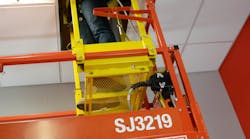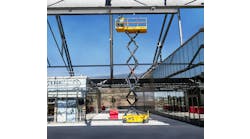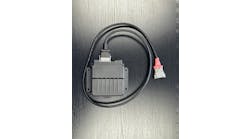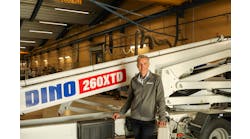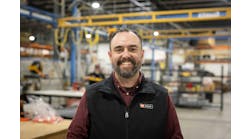Malcolm Early, vice president, marketing, Skyjack Inc., talks with RER about its new stand-on X-Step and other safety advances; the challenge of the current business environment; new vertical mast range; and more.
RER: What new equipment enhancements or developments has your company come up with in the past year?
Early: The last 12 months have been quite busy. While OEMs are continuing to face challenges in supply chain and logistics the rental market has remained positive, and demand is increasing. It has definitely been an opportune time to launch new products.
Skyjack launched the first of those new products with our next generation vertical mast lifts. Following the launch of the award-winning SJ20 E, the new SJ12 E and SJ16 E provide a quiet and versatile package with zero emissions. With a new mast design, direct AC electric drive, drivable at full height, and fewer hydraulic connection points, the SJ12 E, SJ16 E, and SJ20 E boast an increased duty cycle by up to 30 percent.
Secondly, we saw that it was an unfortunate and commonplace practice for operators to stand on railings to gain a little more height to access small areas. For example, standing on the railings to obtain access through suspended ceiling tiles. Skyjack’s XStep helps eliminate this dangerous practice and maximizes reach and productivity by providing operators with safe, increased access into and around tight, restricted spaces and avoids the elevated risk of falling from the platform.
The XStep consists of a swing down base with full height railings that, in turn, is securely mounted on the mid-rails of the scissor lift. Suitable for the current generation of SJ3215 and SJ3219 DC scissors, as well as retrofittable to previous Skyjack DC scissor models and can easily be moved between units, further increasing fleet flexibility. The operator can step up (48cm) into the XStep, close the top rail and work safely gaining extra jobsite access. Important in the design has been the ability for one person to install the XStep in just five minutes without the requirement of special tools or lifting equipment.
To round out the year, we looked at our telehandler range. Initially launched in 2015, Skyjack offers six models within core classes of telehandlers throughout North America. The new changes are a direct result of customer and operator feedback.
While we have made one-off changes to our TH Series throughout the years, these are the first significant design changes that we have done since launching. In doing so, we feel we have increased the return on our customer’s investment by improving reliability, and serviceability.
The core changes include:
- A significant change in the tilt compensation cylinder configuration to utilize a dual cylinder design, to better distribute the load and improve reliability.
- A new high-pressure filter has been added to the hydraulic system to complement the oil return filter and further
- The main boom pivot bearings have been updated to greaseless bearings, removing the need for end users to grease and maintain on job sites; and,
- Highly durable steel cowlings have been introduced. These are highly durable for better onsite protection and are also easier to repair.
RER: Any new achievements or developments in safety equipment or accessories?
Early: Covered in question one, the XStep offers:
- All round fall protection.
- Access to controls.
- Simple installation.
- Increased productivity.
Suitable for the current generation of SJ3215 and SJ3219 DC scissor, as well as previous Skyjack DC scissor models, it can easily be moved between units, further increasing fleet flexibility.
Obviously longer lead times have been a major concern for rental companies with some saying they are waiting a year or even two years for some machines. What steps are you taking to try to reduce these long lead times?
Early: The post-COVID-19 situation represents probably one of the most challenging business environments the access manufacturing business has known. During COVID we used to think we were in unprecedented times yet two years on we see daily challenges that just seem to keep on coming. The issue of availability is compounded by rising costs, global logistic issues, and labor availability. Then one adds another layer with geo-political events such those in Ukraine – energy surcharges, China’s zero-COVID policy with associated lockdowns, and Sri Lanka, an important supplier of the industries’ tires.
Costs and prices have increased, and new issues arise daily. As a business we have seen our backlog for 2022 and 2023 continue to grow. We have daily conversations with customers on lead times, which unfortunately are increasing.
Ultimately, this is means we are looking at our manufacturing footprint with a view to increasing capacity and having an “in-the-market-for-the-market” approach with shorter and more flexible supply chains.
RER: Costs of machines have increased significantly in the recent past? What has led to this cost increase and are you doing anything to try to reduce the cost of new units?
Early: Yes, every issue we face, whether it be availability or logistics or labour, comes with significant cost increases. We have always tried to limit “pass-on” but in today’s environment it is just not practical. While we have increased prices, it far from covers the increased costs we are faced with.
On a day-to-day basis, we face changes down to a component level and are spending significant time and cost at looking for alternatives, testing alternatives, and issuing engineering changes. In the meantime, we are looking at our manufacturing footprint and an “in-the-market-for-a-market” approach.
RER: Have you made any improvements that make machines easier to maintain?
Early: Skyjack became an industry leader by providing machine features that combine durability, quality, and serviceability, making our products world renowned for product reliability. Our team understands the importance of maximum uptime, so our equipment is designed to provide just that. All major service points are easily accessible, enabling straight-forward troubleshooting and repairs.
I mention above in Question 1 some of the changes we made to our telehandler range that epitomize this approach.
Our new vertical mast range now features a new mast design. The multi-stage hydraulic cylinder and inverted multi-section mast with overlaps helps increase rigidity. The new design is free from any chains, sheaves, or bushings to reduce maintenance burden. The larger section at the top of the design prevents debris ingress. Like previous Skyjack vertical masts, the Next Generation models keep the telescopic mast at the rear, which provides a totally unrestricted view from the front-facing control box. This layout also moves the steering wheels away from the mast, which offers excellent maneuverability with zero inside steering radius.
RER: Are electric machines and/or alternative fuel machines more in demand these days and what is your company doing to address that need in the marketplace?
Early: Yes, the subject of electrification is a hot topic. Although I am tempted to say we ought to remember that as an industry, zero-emission DC scissors have led the way for many more years than the duration of the recent debate. At Skyjack the DC scissor and vertical mast are also undergoing change. In our case we introduced our vertical mast with electric drive, and we will see that feature, and its benefits, flow though our other DC-based product ranges.
Returning to internal combustion machines and alternatives such as hybrid and electric, we have teams working on these areas.
Looking more broadly, and more from the viewpoint of sustainability, rental companies and major contractors face increasing demands for sustainability information. This, in part, stems from government initiatives (and budgets) that see sustainability at the core of construction projects, including the use of sustainable machines. Skyjack has introduced its Eco mark to support our customers by providing products that deliver benefits in environmental performance and long-term sustainability.
Are there any other trends you’re expecting to see in MEWPS in the near future?
Early: Sustainability will continue to develop. Geographically we see it more in Europe than North America, but as we see more government initiatives and frankly money coming with a sustainability character, we would expect to see that need grow. As this happens, I think there is a discussion to be had on infrastructure. Not unlike the evolution in electric vehicles. It is all very well having an electric machine, but on a site without a substantial electric supply would the current solution be a conventional fuel-based generator? The rental industry (and OEMs) has some thinking to do. We are used to charging DC scissors. How will facilities need to change to charge booms? It takes 10 minutes to pour diesel into a boom; how will longer charging times be accommodated? I think the conversation will move more away from electrification of the machine and more to the electrification of our industry.
